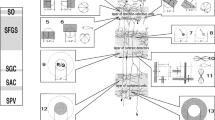Abstract
Analysis of postsynaptic unit responses in the visual center ofRana temporaria showed that optic nerve fibers with high and low conduction velocities usually converge on a single neuron of the tectum opticum (TO). In response to stimulation of the optic nerve a complex depolarization potential consisting of 3 (or possibly 4) EPSPs was recorded in one group of neurons; these EPSPs were probably generated through excitation of several groups of afferent fibers. Either an increase or a decrease in the EPSPs can be observed in the TO neurons in response to repetitive and paired stimulation of the optic nerve. Postsynaptic inhibitory responses of some TO neurons, probably of direct and recurrent origin, are discussed.
Similar content being viewed by others
Literature cited
A. S. Luk'yanov, "Generation of action potentials by dendrites of the frog tectum opticum," Fiziol. Zh. SSSR,56, 1131 (1970).
A. S. Luk'yanov, "Postsynaptic inhibitory responses of some neurons of the frog visual center," Vestn. Moskovsk. Gos. Univ.,5, 84 (1970).
Yu. B. Manteifel', "Analysis of reactive (evoked) potentials of the frog tectum mesencephali," Fiziol. Zh. SSSR,49, 790 (1963).
Yu. B. Manteifel', "Evoked potentials of the visual center of lower vertebrates: genesis and correlation with unit activity," Neirofiziologiya,2, 515 (1970).
Yu. B. Manteifel' and L. N. D'yachkova, "Ultrastructure and functional characteristics of the optic nerve of the frogRana temporaria L. under normal conditions and during degeneration," Neirofiziologiya,2, 627 (1970).
P. Buser, "Analyse des réponses électriques du lobe optique à la stimulation de la voie visuelle chez quelques vertébrés inférieurs. Thèses," Paris, Masson (1955).
G. Lazar and G. Szekely, "Golgi studies on the optic center of the frog," J. Hirnforsch.,9, 329 (1967).
G. Lazar and G. Szekely, "Distribution of optic terminals in the different optic centers of the frog," Brain Res.,16, 1 (1969).
H. R. Maturana, J. Y. Lettvin, W. S. McCulloch, and W. H. Pitts, "Anatomy and physiology of vision in the frog," J. Gen. Physiol.,47, 129 (1960).
B. Peretz, "Vertical distribution of optic nerve fiber termination in the frog optic tectum," Amer. J. Physiol.,217, 181 (1969).
H. D. Potter, "Structural characteristics of cell and fiber population in the optic tectum of the frogRana catesbeiana," J. Comp. Neurol.,136, 203 (1969).
F. Scalia, H. Knapp, M. Halpern, and W. Riss, "New observations on the retinal projection in the frog brain," Behavior and Evolution,1, 324 (1968).
Additional information
M. V. Lomonosov Moscow State University. Translated from Neirofiziologiya, Vol. 3, No. 6, pp. 637–643, November–December, 1971.
Rights and permissions
About this article
Cite this article
Gusel'nikov, V.I., Luk'yanov, A.S. Excitation and inhibition in the visual center of Rana temporaria. Neurophysiology 3, 476–480 (1971). https://doi.org/10.1007/BF01063761
Received:
Issue Date:
DOI: https://doi.org/10.1007/BF01063761




